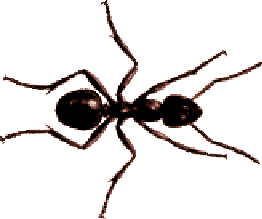
The illustration at left is of Lasius Niger which may be black or the very dark brown colour shown here. They vary in size from 3 mm to 5 mm in length, although the fertile sexual insects are a good deal larger, longer and have wings. Other types of ant have variously coloured bodies, wood ants having a red/brown almost transparent appearance.
Ants do not attack the bees themselves although they may well eat the carcase of a dead bee. They steal honey from the hive and in some areas the losses can be a significant percentage of the crop.
Physical rather than chemical controls are what is required as the ants lay a pheromone trail that other ants can follow. In regions where ants are a nuisance it is customary to place the hive stand so that it's legs are within four tin cans that are part filled with old motor oil. This forms a barrier that the ants cannot cross, there is a problem with this method in that if it rains, the tin cans are filled up with water and the oil floats over the edge of the can, leaving water in it's place. The water is not so effective a barrier as the oil. If this is a problem it can be solved by forming shallow aluminium cones fixed to the stand legs so that they shroud the tins containing the oil barrier from falling rain.
Care should be taken that grass or other vegetaion does not grow up near the hive or stand as this could form a bridge for the ants to bypass the oil tins.
If the hives are standing on a concrete base, the pheromone trail can be broken by spraying with a domestic cleaning product made from oranges, called "De-Solv-It" this is a solvent product from Orange-Sol that is excellent at removing wax, propolis, road tar and other hard to shift waxes and resins. (This tip came from Ettamarie Peterson)
Since the first version of this page was written, various other orange oil based cleaning products have come on to the UK market and I would imagine that these are equally as effective at disrupting the pheromone trails.